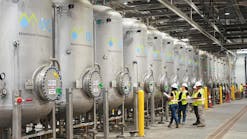Custom-engineered solution maintains sterility and cleanability in a mammalian bioreactor by enforcing seal integrity
TARRYTOWN, NY, Dec. 21, 2005 -- When Regeneron Pharmaceuticals Inc. purchased a new mammalian bioreactor skid, it had the same high expectations that surround any major process improvement.
But during initial startup, it became apparent that the vessel would not maintain sterility reliably, due in part to the design of the OEM bottom-entry agitator seal. According to Regeneron facilities engineering supervisor Kyle Cherry, the reactor was "problematic."
Leaks Affect Sterilization
"The main issue with the OEM seal was that the sterilization requirement hadn't been observed and sealing integrity was compromised," says Cherry.
Sterilization of the interior vessel bore was absolutely essential. Once this requirement was met, the bioreactor had to cool to a temperature appropriate for introducing the cell culture medium.
The hitch was that the OEM seal faces were not oriented suitably to foster complete sterility. In addition, the port locations were not optimal for total evacuation of air, causing the inner seal to let in vapor. Because clean steam was used for sterilizing the bioreactor, a moderate flow of clean steam-condensate became the barrier fluid to the mechanical seal assembly during certain phases of production.
A Custom-Engineered Solution
Undisrupted production did not begin until shortly after the OEM agitator shaft seal was replaced with a custom-engineered design from Flowserve Flow Solutions. While both the OEM seal and the Flowserve replacement featured a dual mechanical seal to protect the sterility of the cell culture medium and a secondary sealing device to protect the gearbox, the difference, says Cherry, "is that the OEM seal had cleanability issues making it unable to maintain a sterile environment."
"Flowserve customized a model ST seal to address the repetitive seal problems," says Cherry. The new seal was designed as a dual cartridge seal that mounted directly to the gearbox as well as to the bioreactor's mounting pad. An additional part of the challenge was that the European design and the transverse angle of the drive required detailed field measurement by Flowserve for proper fit and function.
The Flowserve ST Seal
Installing the Flowserve ST seal as a complete unit provides numerous advantages. The ST seal requires no handling of integral sealing components, has fewer components to stock and maintain, and includes a complete cartridge that can be aerostatically pressure-tested to ensure integrity before installation.
Relocating the springs outside the process media and contouring critical sealing components to resist pooling also fostered optimal cleanability and sterility. Adding a flexible stator design compensated for misalignment and mixing anomalies that can occur under normal operation.
The new Flowserve seal maintains absolute containment of the clean steam condensate during each phase of production. By incorporating an internal flow deflector, the primary seal is kept lubricated to eliminate dry run conditions. A Flowserve Bearing Gard II unit was added to eliminate condensate weepage from penetrating the gearbox.
These are just a few of the critical design advantages of the Flowserve ST seal.
Choosing the Solution
When asked why Regeneron chose Flowserve, Cherry explains that Flowserve had engineered sealing solutions for several Regeneron bacterial fermentation reactors over the years, and that those had performed as promised.
In this case, because the reactor was too large for a magnetic drive, a mechanical seal was needed. "Although this is a bottom-entry agitator at a slight transverse angle, and the previous Flowserve-Regeneron projects were for top-entry agitators, Flowserve didn't seem to have any problem getting the job done," says Cherry.
Because the seal is in contact with the process medium, mammalian reactors require a high level of reliability. Positive containment is also critical. Cherry says that with the Flowserve seal and some small piping modifications and procedural changes, "We are able to maintain sterility for extended periods."
"This issue was an ongoing challenge for us," adds Cherry. "The Flowserve seals team worked closely with our technicians and engineering department on the field retro-fit and came up with the solution we needed."
Based in Irvine, Texas, near Dallas, Flowserve Corp. (www.flowserve.com) is one of the world's leading providers of fluid motion and control products and services. Operating in 56 countries, the company produces engineered and industrial pumps, seals and valves as well as a range of related flow management services.
###


